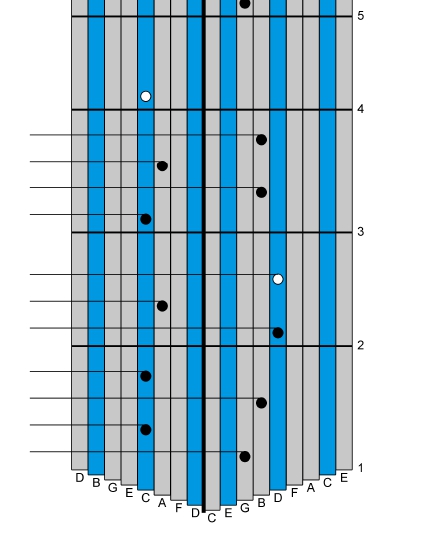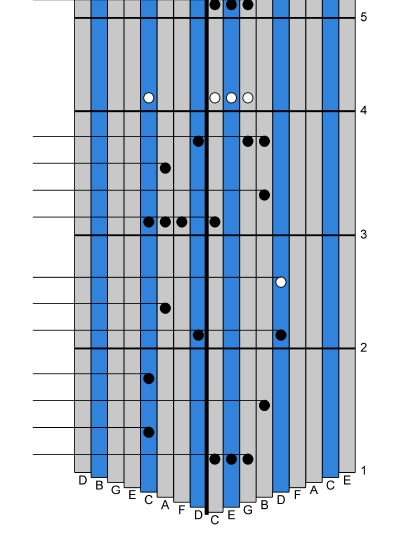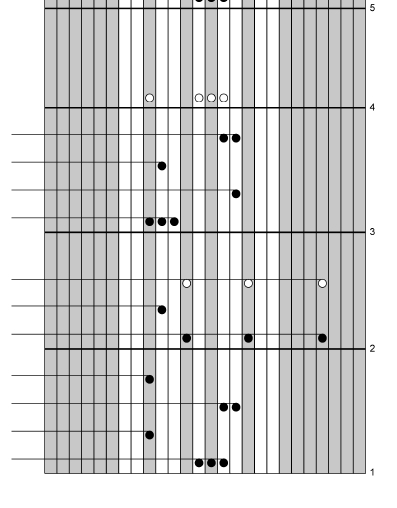
Use of this website constitutes acceptance of the Privacy Policy and User Agreement. Copyright © 2020 Kalimba Magic. All Rights Reserved.
A Kalimba Magic customer recently expressed the desire to play the eternally popular “Love Me Tender” on their 17-Note Kalimba in C, and the result is this blog post and free tablature for everyone to learn it. The 17-Note C Kalimba tablature is also usable with a 15-Note ALTO kalimba, and if you have Alto kalimba tablature, you can use it for your 17-Note in C – just be aware that the note names will be shifted by a 4th.
What’s cool about this post is that we break the music down into three versions (on tablature AND on video!) – melody only, melody plus chords, and melody plus fully chromatic chords. This makes it so easy for you that it practically plays itself. Give it a look!
The video that plays automatically when you load this page plays all three versions of “Love Me Tender.” The first is melody only (well, there are two spots with an added harmony note), followed by a melody-plus-harmony version, and ending with a version with melody and chromatic harmonies (played on the Chromatic kalimba).
And you can get the tablature for each of these three versions by clicking below.
 “Love Me Tender” is a Level 1 Melody – meaning it is straightforward and there is nothing too tricky about it. It’s just quarter notes and half notes, with no harmony notes. No matter what level kalimba player you are, you should be able to start playing “Love Me Tender” today on your 17-Note or 15-Note kalimba.Download Tablature PDF
“Love Me Tender” is a Level 1 Melody – meaning it is straightforward and there is nothing too tricky about it. It’s just quarter notes and half notes, with no harmony notes. No matter what level kalimba player you are, you should be able to start playing “Love Me Tender” today on your 17-Note or 15-Note kalimba.Download Tablature PDF
 When you have the melody down, move on to the PDF of the tablature that adds chords to the melody. Click on the image or the link below to download the free tablature.
When you have the melody down, move on to the PDF of the tablature that adds chords to the melody. Click on the image or the link below to download the free tablature.
In kalimba music, chords are often added on the first beat of a measure.
Sometimes, chords are made on the tines immediately adjacent to the melody note, usually adding lower notes. You can see this on the first beat of measure 1.
Other chords are made with notes on the opposite side of the kalimba. When that happens, the harmony notes are usually played much lower on the kalimba. This is seen on the first beat of measure 2.
On the first beat of measure 3, we see a chord that uses both of these harmonizing rules of thumb: the melody note is the high C, and the two lower adjacent tines, A and F, are added… but the low C is also added, making a very full chord to support the music.
This sounds great, and it looks a bit scary, but really, it is not difficult to do.Download Tablature PDF
 Some of the harmonies on the previous version sounded a bit thin, and that’s because the notes that are required to do the full song are not on the diatonic kalimba. On the chromatic kalimba, however, you can get those previously missing magical notes from the back side of the instrument, which is played with the fingers.
Some of the harmonies on the previous version sounded a bit thin, and that’s because the notes that are required to do the full song are not on the diatonic kalimba. On the chromatic kalimba, however, you can get those previously missing magical notes from the back side of the instrument, which is played with the fingers.
On the chromatic tablature, the six painted tines are represented by the six innermost gray columns. The outer 11 gray columns represent the back-side notes. You can see the chord on measure two uses a back-side note to accomplish the full harmony which is a D major chord, with its F# from the back side.
While I generally advise that playing harmonies on the kalimba is easy, playing chromatic harmonies on a kalimba is not so easy. You have to be very familiar with your kalimba, at each instant knowing exactly what notes you need, and where they are found on this challenging instrument.
That said, there are actually some amazing chromatic kalimba players in the world, so it is not out of reach to one who works at this instrument.Download Tablature PDF


Sign up for our newsletter and free resources with your email address:
We pinky promise not to spam you and to only send good stuff.
 Assist Paul Tracey Rebuild His House in Pacific Palisades
Assist Paul Tracey Rebuild His House in Pacific Palisades 8-Note Spiral Kalimba Turned into a Student Karimba
8-Note Spiral Kalimba Turned into a Student Karimba Seek to Infuse Your Musical Moments With Beauty and Magic
Seek to Infuse Your Musical Moments With Beauty and MagicUse of this website constitutes acceptance of the Privacy Policy and User Agreement. Copyright © 2020 Kalimba Magic. All Rights Reserved.